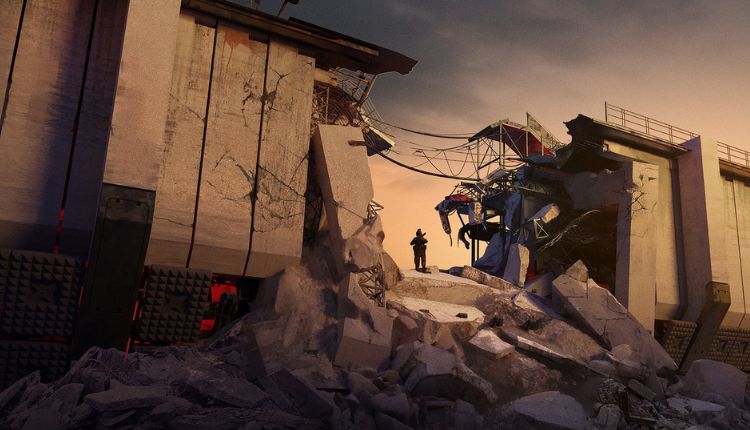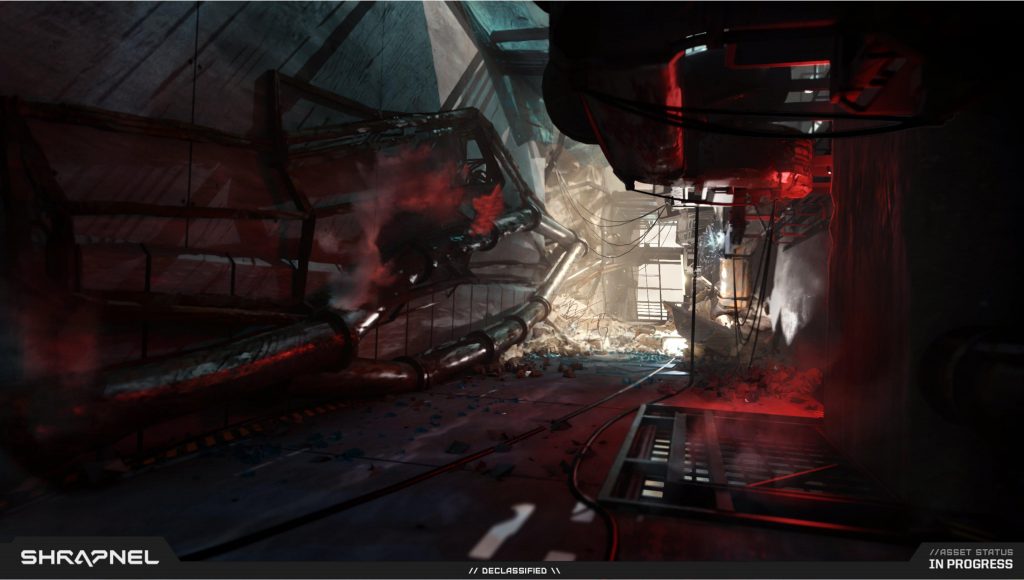Building Shrapnel, the first blockchain-enabled triple-A shooter

The pedigree of the team behind upcoming loot-extraction shooter Shrapnel should turn heads. Neon Machine – recently installed in new offices in Seattle – is a coming-together of veterans from companies including HBO, Microsoft, ConsenSys and NVidia.
It’s also raised over $10.5 million in 2021 to build a triple-A multiplayer game powered by blockchain tech.
HBO GO – which became HBO NOW and then HBO MAX – was based in Seattle. Neon Machine COO Aaron Nonis and some of his new colleagues worked there. “I had a mission to create the games of HBO,” he says.
“I set up a streaming service. I set up a distribution platform that would ultimately be able to host those sorts of things. And from about 2015, VR started to become a big thing. We loved putting together a Westworld experience that won an Emmy.”

Now also working on Shrapnel, Colin Foran, chief creative officer, Naomi Lackaff, head of partnerships, and Mark Long, CEO, all worked at HBO on that Westworld VR experience with Nonis.
Famously, Microsoft is also in the Seattle area, over the water in Redmond. Shrapnel’s studio head Don Norbury was previously at Microsoft Games Studios Publishing. Mark Yeend, head of marcom and community, came from Microsoft.
A blockchain-enabled first-person-shooter
We meet some of these heavyweights during GDC week in San Francisco when Shrapnel – still some months away from completion – is revealed to the press in a small suite under the Grand Hyatt hotel.
But BlockchainGamer.biz doesn’t like to share, so we followed COO Aaron Nonis back to Seattle and hung out in the new waterfront office in search of more detail.
“Can this be the world’s first blockchain-enabled triple-A first-person shooter?” enthuses Nonis introducing the game as we sit down for a one-on-one chat about Neon Machine’s philosophy and aspirations.
The team is also banking on loot extraction being the next big thing in competitive games, the way that the battle royale template has dominated the last few years.
Nonis dives in: “We firmly believe loot extraction will be a core genre moving forward. There are loot runners out there, and it’s kind of a big moment in time. But more than that, we believe that that model, where you put in work to extract things from the world, is the thing that brings value. If you want to establish a true sense of value and a true sense of ownership, you have to have some effort into what’s going on there. That’s the core part of the game.”
A transmedia science fiction setting
The central premise is that you will extract loot from each level during combat bouts, and you own that loot. There is an IP tying this all together, justifying the game’s actions and connecting the franchise’s various parts.
The Shrapnel world materialised at GDC, a fully-formed science fiction environment with a backstory.
In 2038, an asteroid collision with the Moon leads to debris falling to Earth, creating an uninhabited strip called the Sacrifice Zone. It’s a dangerous area still bombarded by lunar meteorites. The corporations discover a valuable ore there – nicknamed “shrapnel” – that can be refined into potent compounds. There’s a struggle for control, and corporations hire mercenaries to operate there. In the game’s time frame of 2044, players assume the role of an operator in the Mercenary Extraction Force, entering the Sacrifice Zone to compete for pieces of Shrapnel.
This story of the destroyed Moon and Earth’s resource-rich Sacrifice Zone, where corporate soldiers come out to play, fuels all parts of the Shrapnel experience, even beyond the core multiplayer game.
“I’m going to use a dirty word – transmedia!” laughs Nonis. “It’s in the soul of all of the founders. We’ve been thinking about world-building and multiple venues where we can tell stories, both in narrative fiction, in linear media, in non-linear media, in XR media.”
Our chat references the convergence of technology, how Unreal is behind the virtual sets of The Mandalorian, and how The Last of Us proves that gaming narratives can work on TV. Nonis also references Dungeons & Dragons and Warhammer, which are “participatory” narratives on the tabletop, but also work in fiction.
The world of Shrapnel could allow any number of stories, both linear and created by the player, to emerge. And enabling all that is a set of creator tools.
User-generated content is the future
“The first thing people want to do is ‘customise’,” he says. “So the first tool that’s making its way out into the public is the Insignia Creator tool. That’s the thing you got to experience at GDC. That leverages our pre-packaged decals; you can mix and match them to create an identity.
“But creation is really hard. There’ll be people who are more adept at it. So a big part of our scheme is to enable those creators to come in, and do some work, and be able to post these things up on a marketplace, and exchange them with other players that might want to absorb them.”
Following the Insignia Creator, you’ll also be able to customise skins and gear fully. Then there will be a set of map tools that will ultimately enable you to design your own Shrapnel levels, as outlined in the original Shrapnel whitepaper.
Aaron Nonis reminds us that back in the day, creating levels for Doom and Quake was huge in the community. “Some of those became as popular as the game itself, right?” he muses. “I remember all of my multiplayer sessions. In Quake, I have one of those player memories: peeking around the corner, firing a rocket, thinking somebody was up there. The next thing you know: a head bounces in front of me! It wasn’t in a basic map. It was one of those modded Quake maps that somebody had made.”
Drawing attention to how big user-generated content was at GDC 2023, Nonis points out how Unity and Unreal have lowered the barrier to people getting into game design and how “Roblox and Minecraft preceded Fortnite” to turn players into creators.
The intersection of gaming, creativity, and web3
“Gaming is as relevant in modern storytelling as linear media is, for this generation,” says Nonis on narrative and creativity. “In that sense, we now have a ‘the kids have gone through Roblox’ moment. They grew up with Roblox. It’s been out for 10-plus years!
“So many people used Roblox through their formative years. And this is one of the cool premises for UGC. A generation may have grown out of what Roblox has to offer, and they want a medium that’s a little bit more elaborate. We provide a unique IP and a unique framing for people to be able to do some creative work.”

Another element to this is the blockchain marketplace the team are building and the economy that’s part of it. What is Shrapnel hoping to achieve with the web3 angle? Like other games companies talking about blockchain in 2023, this team is adamant that web3, for them, isn’t a technology being used for its own sake.
“We’re looking for a cohesive strategy that only makes sense when the pieces are working together,” says Nonis. “This is not about finding an excuse to use the latest fad. We’re going to do something with it. What does it mean to own something? What gives it value?”
Objects on the blockchain
The team isn’t using the word blockchain often – instead using terms like “digital object ownership” and “interoperable digital objects”.
The Shrapnel team hired Marc Mercuri, whose background is Azure Blockchain, Microsoft’s journey into web3. Mercuri leads the conversation at Shrapnel about which chains to use and the central philosophy around ownership. Together they evaluated elements such as which chain has the most negligible environmental impact, is easiest to use, and has the best security.
“It’s the ability for a consumer to be able to take the digital creation and either resell it, or reuse it, and take it to other mediums,” says Nonis. “We go back to the transmedia story. These things are all parts of that foundational technology.”
Ultimately, the team went with the Avalanche blockchain ecosystem. “We can create a level two-ish chain. Our chain sits within Avalanche and gives us all the performance we want. It is exclusive to us,” explains Nonis.
“We control the security. We are leveraging the Avalanche blockchain technology, but we have an internal blockchain team doing a lot of subnet development and modelling our smart contracts. There’s certainly novelty in what’s being generated here on the blockchain side.”
Reputation, rewards and record-keeping
Because of the permanent record that blockchain provides, the team thinks there is an opportunity here to reflect the consequences of people’s actions, which will benefit the community.
“Part of what we’re trying to build into the project is a sense of reputation,” says Aaron Nonis. “When you have user-generated content, you’ll have things that are great, and things that are not great, and things that are quite offensive. In first-person shooter games, you have people who are having a good time and sometimes people who are griefing other people. Part of the system we’re building is this reputation across the board.”
You can still be mostly anonymous, but with planning, the team will be able to motivate good behaviours, rewarding people for participating and keeping a reputational record.
As Nonis puts it, “My wallet is a wallet that has very real ramifications to it. Suppose I start behaving badly in the ecosystem. In that case, you can put some really interesting consequences there from a reputation perspective.”

Shrapnel is likely to be playable later in 2023. The best way to keep up with its progress and contribute to the community is to join the official Discord.
There is more information about the game’s lore on the Shrapnel website. Neon Machine is hiring at the moment in Seattle. (If you are looking for games work at the moment, browse other industry jobs here).
Don’t miss out on any news from the blockchain games space: follow us on Twitter and connect with us on Linkedin.
